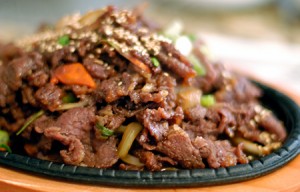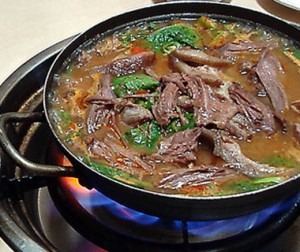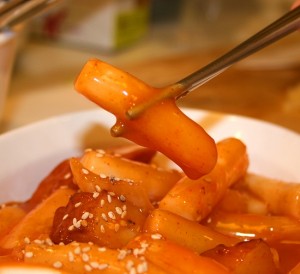 A couple of months ago, we here at Seoulbeats shared our favorite Korean foods in a Roundtable discussion. But do average Koreans really eat the way that dramas — and Korean restaurants sprinkled across the United States and Europe — portray them as eating? Today’s Korean culture lesson takes us out of the classroom and into the kitchen (figuratively, unfortunately). Got your chopsticks ready?
A couple of months ago, we here at Seoulbeats shared our favorite Korean foods in a Roundtable discussion. But do average Koreans really eat the way that dramas — and Korean restaurants sprinkled across the United States and Europe — portray them as eating? Today’s Korean culture lesson takes us out of the classroom and into the kitchen (figuratively, unfortunately). Got your chopsticks ready?
First off, let’s talk meat. As a lot of our readers might know, the Korean word for “meat” is kogi, and restaurants that specialize in serving Korean barbecue are called kogi-jib (jib means “house,” so it literally translates to “meat house”). It’s probably fair to say that Korean barbecue restaurants are some of the most well-known and famous Korean restaurants; the popular “K-town” strip in New York City (E 32nd Street and Broadway, for interested readers) is dotted with a number of mouth-watering and high-quality barbecue restaurants, and their popularity likely stems from their palatability to foreign taste buds. Meat marinades will often use soy sauce and sugar, producing a sweet, sticky, and delicious meal that everyone (except vegetarians) will probably love.
Beef (so), pork (dweji), and duck (ori) are all popular offerings at kogi-jib (though you’ll more likely find duck at specialty houses). Turkey and lamb are less common. Perhaps the most well-known meat preparations are bulgogi (sliced and seasoned barbecued beef) and kalbi (ribs on the bone); skirt meat (called kalmaegi-sal) is also extremely delicious, but don’t be fooled by the name — even though kalmaegi means “seagull” in Korean, it is usually pork.
How should you eat Korean barbecue? Everyone has their own preferred method of getting meat into their mouths as quickly and deliciously as possible, but a favored method of consumption is making a lettuce wrap out of the lettuce leaves and accoutrements that accompany most meals at barbecue restaurants. Place some meat in a lettuce leaf (or sesame leaf — these are often provided as well), add some ssamjang (a mix of red pepper paste and fermented bean paste), some roasted garlic, and maybe some rice if you’ve got room. Wrap it up as tightly as you can and stick the whole thing in your mouth. Definitely not the most glamorous way to consume meat (try not to choke), but I think you’ll be pleasantly surprised by how well everything goes together.
 And yes, if you go to specialty restaurants only, you can sample the still-somewhat-popular boshintang — dog meat soup. There are still a number of dog farms in South Korea that raise dogs for slaughter just as you would cows or sheep and provide dog meat to restaurants. Dog meat has a reputation for being popular with middle-aged men more so than it does with any other demographic, but adventurous eaters of all ages and genders can give it a try if they’re ever in South Korea.
And yes, if you go to specialty restaurants only, you can sample the still-somewhat-popular boshintang — dog meat soup. There are still a number of dog farms in South Korea that raise dogs for slaughter just as you would cows or sheep and provide dog meat to restaurants. Dog meat has a reputation for being popular with middle-aged men more so than it does with any other demographic, but adventurous eaters of all ages and genders can give it a try if they’re ever in South Korea.
Despite the proliferation of Korean barbecue restaurants and the propensity of characters in Korean dramas to eat really, really fantastic-looking meat, ordinary Korean citizens aren’t exactly consuming barbecue like it’s going out of style. In fact, meat dishes — and the limited ways in which they are prepared — make up a comparatively small portion of the Korean diet. On a normal day, Korean families will usually eat meals comprised of rice, an accompanying soup or stew, and a smattering of small (usually vegetable) side dishes called banchan. Banchan are a staple of Korean cuisine and nearly limitless in their varieties; there is the easily recognizable spicy red kimchi (and kimchi in and of itself can be made out of any number of different vegetables and take on a number of shapes, forms, and textures), the ambiguous acorn jelly, and cubed pickled radish, to name just a few. Banchan are always provided free of charge at Korean restaurants, and if you finish one up, feel free to just ask the wait staff for more by shouting “yogiyo” (Over here!) over the din of the restaurant. I promise, it’s not impolite.
Korean soups and stews (called jjigae) are robust in flavor, often spicy, and loaded up with a variety of ingredients; kimchi and pork belly are usually found in kimchi stew, while tofu, zucchini, and mushrooms accompany soybean paste stew (and there are far more kinds of stew than just these). On first taste, stews may seem overwhelming and overzealous, but keep in mind that they are intended to be consumed together with rice. Good white rice (it’s not easy to find brown rice in South Korea) will marry nicely with the sharp flavors of the stews. Unless you’re a huge spicy food buff, Korean stews might take a little bit of getting used to, and this probably accounts for why most Korean restaurants are heavy on the barbecue dishes; despite the fact that stews are far more commonly consumed in South Korea, the overemphasis on barbecue has led to a potentially skewed understanding of Korean cuisine. However, give stews a chance — they’re unlike anything else you’ll ever try, and you might just wind up falling in love.
For a nice sampling of Korean soups and other popular, everyday fare outside the home (including the much-loved mixed-rice dish known as bibimbap, assorted fried rice dishes, Korean interpretations of Chinese black-bean noodles and sweet and sour pork, and cold noodle soup), Koreans will often head to bunsikjeom. Though this translates loosely to “snack house,” these sorts of restaurants will usually carry all sorts of standard Korean meals. A popular chain bunsikjeom is called Kimbap Heaven and can be found in abundance particularly near universities — students will cram into these restaurants eager for a taste of home in between classes. As the name implies, it specializes in kimbap — a Korean interpretation of Japanese maki rolls, filled with vegetables and flavored with sesame — but their menu has expanded to include pretty much everything your heart could possibly desire,  sans the barbecue.
sans the barbecue.
We’ll close today’s lesson with a nod to the drama buffs, who have no doubt seen many a protagonist (and probably an antagonist or two as well) seat themselves at a small tent and consume a variety of steaming hot and tasty-looking foodstuffs. These sorts of tents are called pojang-macha (pojang means “take out”), and they are ubiquitous, cheap, and open far later than are most restaurants. Common pojang-macha foods include the aforementioned kimbap, ddeokbokki (rice cakes in a spicy sauce), odeng (fish cake, usually served on a stick), soondae (stuffed pig intenstines), twigim (batter-fried vegetables and rice rolls) and dumplings. Not all pojang-macha will serve alcohol, but some will offer bottles of soju to help you wash down all that awesome food.
Korean food is far too complex and fascinating to describe in just 1000 words, but hopefully this will help you make a bit more sense of what your favorite idols stars consume (and where they are consuming it) on television in the future! Questions, comments, or funny stories? Leave them below!


